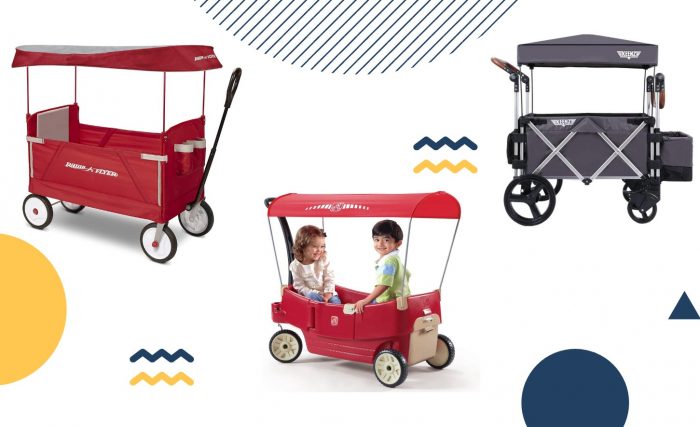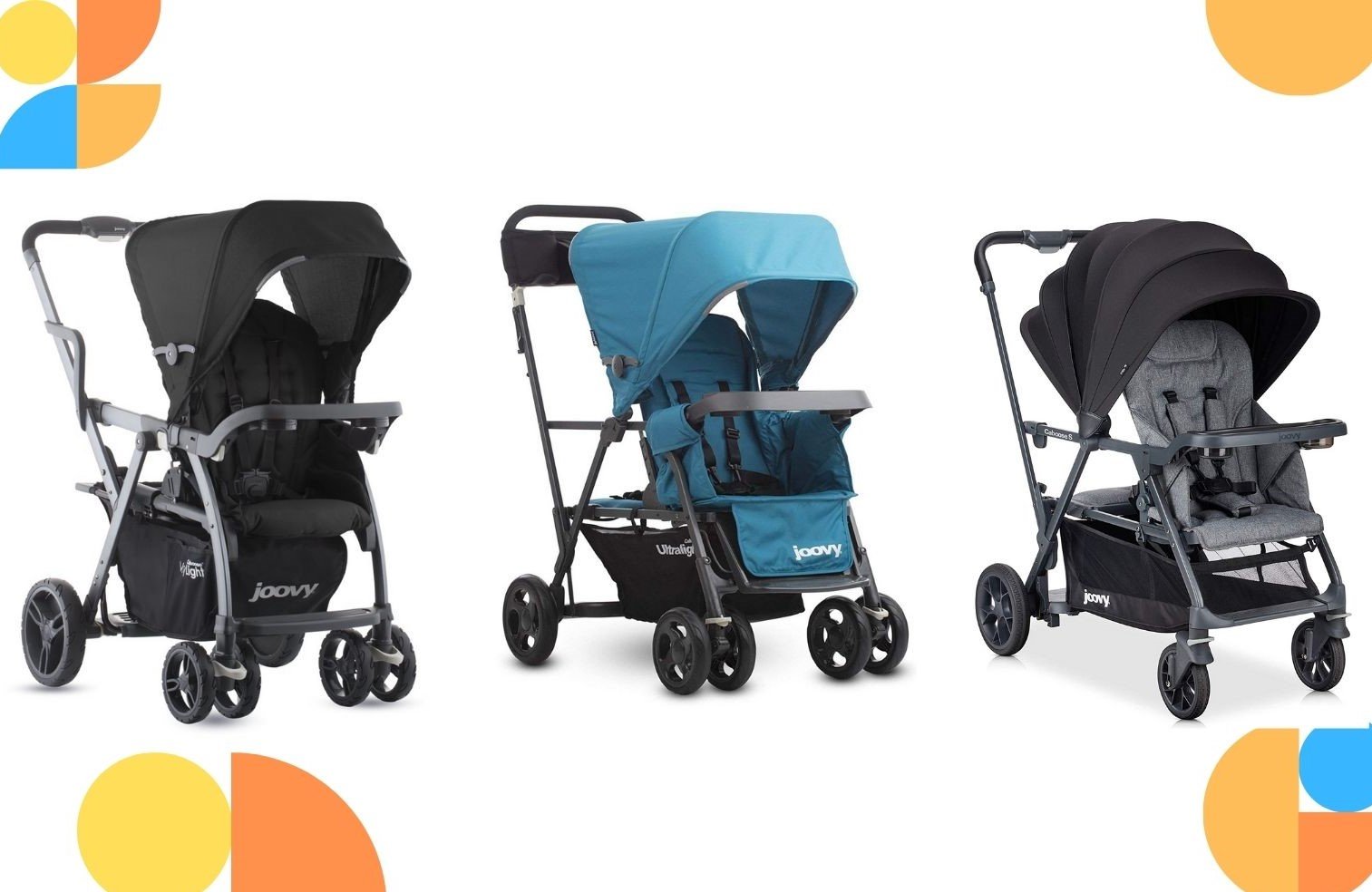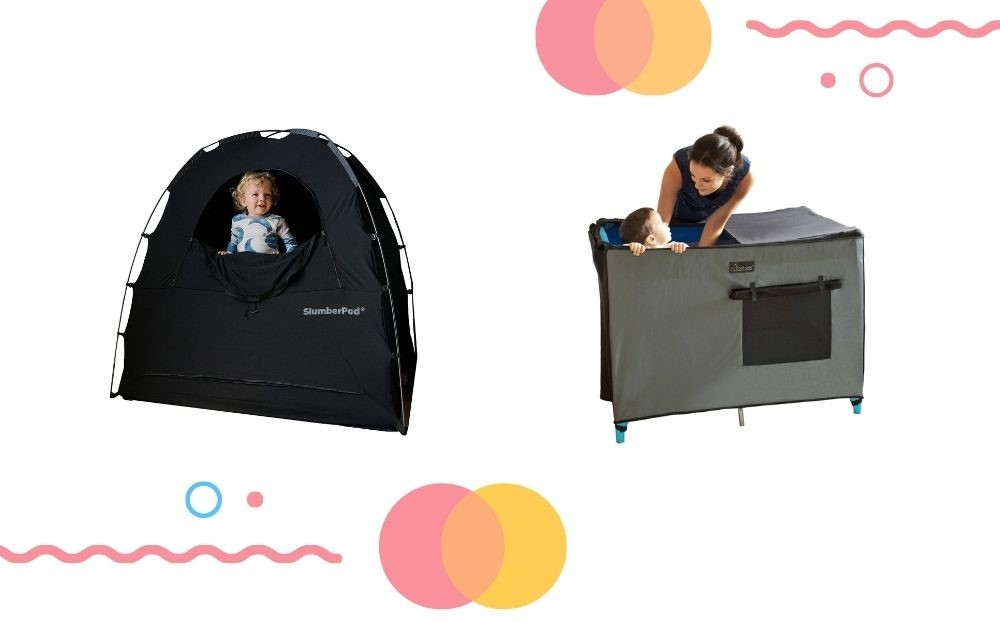Many parents are hesitant about whether they should get a wagon vs stroller. Before you purchase for this expensive baby gear, you should take a look at their main similarities and differences, and then decide which one is for you.
In this article, we will cover everything you know about kids’ pull-along wagons and baby strollers. You can also jump directly to the comparison of wagon vs stroller. Let’s get right to it.
Our Final Recommendations

Everything You Need to Know about Wagons
What is a wagon?
A toy wagon is an open-top structure that resembles a traditional wagon. Its main purpose is to hold belongings and kids. Toy wagons are manually powered by parents.
The most conventional toy wagon has a box-shaped cargo container, four equal-sized wheels, and a parent pulling handle.
In today’s market, you will see lots of multi-use wagon variations. Some are combos of wagons and strollers, some are built for tough terrains, and some are designed to attach to adults’ bicycles.
Who should use a wagon?
In general, wagons are used for toddlers and kids between 18 months and 5 years. That’s because most wagons don’t have comprehensive safety protection for infants.
However, there are wagon and stroller combos, such as Pivot Xplore Double Stroller Wagon, that are designed for babies as young as 6 months. On the other side of the spectrum, there are wagons with large weight limits, such as Step 2 All Around Canopy Wagon, that can fit kids as old as 10 years old.
Popular types of wagons
If there is only one type of kid wagon, then this article won’t be necessary because it’s straight forward to make a selection. The reality is that there are many different types of wagons today. Let’s take a look at all of them.
Simple Pull-Along Wagon
Traditional pull-along wagons are the simplest and most common. They generally consist of three or four wheels, a rectangular holder for kids and belongings, a sun canopy, and a parent handle. This type of wagons can be made with durable fabric, wood, or plastic.
For example, Step 2 All Around Canopy Wagon is a typical plastic pull-along wagon with a simple design.
Folding Wagon Cart
Folding wagon carts are mostly made of weather-proof fabric and metal or plastic frames. They can fold flat to fit in a car trunk or small storage space.
One of the most popular examples is the Radio Flyer EZ Folding Wagon. You can fold this wagon by pulling the strap in the middle of the seat.
Stroller Wagon Combo
Stroller wagon combos are designed for babies, toddlers, and younger kids. They usually have an extendable sun cover. This type of wagon is powered by pushing rather than pulling.
In the picture below, you can see that Pivot Xplore Double Stroller Wagon resembles a regular stroller.
Walker Wagon
Walker wagons serve two purposes: holding kids or belongs, and letting kids practice walking. They are shorter and lighter for kids to maneuver. Additionally, they usually don’t come with accessories such as canopies or storage bags.
A great example is the Radio Flyer Classic Walker Wagon. It also functions as a sit-to-stand toddler walker.

Everything You Need to Know about Strollers
What is a stroller?
Strollers are also called pushchairs or buggies in British English. It is a device used to transport infants and babies up to 3 years old.
Strollers have more safety features such as five-point safety harnesses and guardrails. Additionally, they are equipped with reclining seats and footrests so babies can nap inside.
Who should use a stroller?
Strollers are mainly designed for newborns and toddlers. Therefore, the age range is generally 0 to 36 months.
Your child is likely to grow out of a baby stroller at around 2 to 3 years. By then, they will prefer to ride on a guided tricycle or a wagon.
Popular types of strollers
Just like wagons, there are many variations of strollers on the market today. They all have different focuses on things such as portability, holding multiple kids, suitability for jogging, etc. Let’s take a look at the most popular types of strollers.
Conventional Full-Sized Stroller
A conventional full-sized stroller has a triangle frame that can fold flat. It usually has a reclining seat for a baby to sit upright or lay back. They are suitable for infants who haven’t developed the ability to hold their heads straight.
The example below is one of the most well-received conventional stroller – UppaBaby Cruz Stroller.
Lightweight Umbrella Stroller
Lightweight umbrella strollers are for toddlers and young kids. They are designed to be foldable and easy-to-carry. They are primarily used for day trips or traveling.
Umbrella strollers tend to have smaller wheels thus more difficult to maneuver. Additionally, they don’t have as many safety features as a conventional stroller. That’s why they are mainly used for kids because children at this age have better body coordination and balance.
Below is Disney Umbrella Stroller. It is designed for long-trips such as a visit to the Disney theme parks.
All-In-One Travel System
Though it’s named travel system, this type of stroller is usually not great for travel because they are heavy and bulky. It is designed to accommodate infants, toddlers, as well as kids as they transition from one stage to another.
There are multiple ways to use a travel system. For example, you can mount a car seat on a travel system while your baby is sleeping, you can place a bassinet on it to let your infant lay on her back, and you can let a toddler sit upright on her own.
For example, Maxi-Cosi Zelia Max 5-in-1 is a popular modular travel system for infants and toddlers.

Double or Triple Stroller
A double or triple stroller is a conventional full-size stroller with two or more seats. They are suitable for parents who have twins, triplets, or those who have multiple kids in a similar age range.
Below is Joovy Big Caboose Triple Stroller. It can fit a baby, a toddler, and a kid at the same time.
Stroller Tricycle Combo
A stroller tricycle combo is a hybrid of a stroller and a tricycle. They are usually designed for babies older than 9 months. Besides resting inside the vehicle, your child can also pedal and steer depending on her age and ability.
One popular stroller tricycle combo is Costzon Foldable Steer Stroller. It has six ways of use, ranging from a stroller to a full-fledged toddler trike. You can know more from our review of the Costzon 6-in-1 Tricycle.
Detailed Comparison of Wagon vs Stroller
Now that you have a full picture of what wagons and strollers are, as well as who they are meant for. Let’s take a look at the key differences so that you can decide which one is for you.
1. Ways of use
Similarities: Kids can sit upright in both wagons and strollers.
Differences: The main way to use a stroller is for a baby or toddler to sit inside in one position. Comparatively, wagons have more ways of use. Kids can sit inside, sit on the edge, lay flat, or stand in a wagon. Additionally, a child can come out and pull the wagon by himself.

2. Age Range
Similarities: Both wagons and strollers can be used for kids between 18 to 36 months.
Differences: Most strollers are designed for infants and toddlers. You will need a stroller that can hold a car seat or bassinet if you have a newborn.
But what is the upper age limit for a stroller? The American Academy of Pediatrics recommends that a stroller should be eliminated by age 3.
As we mentioned earlier, wagons are designed mostly for kids between 18 months and 5 years. There are stroller wagons that are suitable for 6-month-old infants, as well as 10-year-old kids.
What do all these mean to you? If you just had a newborn, we recommend that you get a proper stroller. You can always transition to a wagon when your child turns 18 months.
If your child is above 12 months, you should consider a wagon because it’s more fun, interactive, and promotes physical development.
3. Performance on Different Terrains
Similarities: Both wagons and strollers can be used on flat outdoor grounds such as paved sidewalks, grass, or concrete grounds.
Differences: Strollers are designed to ensure the safety and comfort of a small baby. Therefore, they are mainly used for regular transportation purposes such as walking or jogging on a hard flat surface. Using a stroller on uneven ground can damage the tires and alignment.
Comparing to strollers, wagons can travel well on many uncommon terrains such as the beach, muddy roads, farms, or hiking trails.
Tips: Not all wagons are designed for tough terrains. Make sure to get all-terrain wheels or beach wheels to ensure a smoother ride.

4. Capacity to Hold Multiple Kids
Similarities: Both wagons and strollers can be used to carry at least one child.
Differences: Except for double or triple strollers, all other strollers are designed to carry one child, though some single strollers are designed to allow another kid to stand on the frame.
Wagons are designed to hold two children plus loads of belongings. The load capacity of most wagons ranges from 70 pounds to 100 pounds. Theoretically, it can hold more children as long as they are secured in the wagon or the wagon is parked still.
Another reason that wagons can hold more children is that many wagons don’t have raised seats. Since the cart is a walled area with a flat bottom, children can sit, lie down, or stand inside. Additionally, there are wagons, such as Step 2 Choo Choo Train, that are designed for more than two kids.
5. Safety features
Similarities: Both wagons and strollers have safety harnesses.
Differences: In general, strollers have better safety protections than wagons. For example, strollers usually have five-point harnesses, body guardrail, and padded seat and seatback. Additionally, they generally have large rubber tires that can rotate 360 degrees. On top of that, the wheels have better suspension for uneven grounds.
The only exception though is umbrella strollers because they sacrificed the tires and padding for portability.
Wagons usually have fewer safety mechanisms because they are mostly designed for toddlers and kids. Most wagons have three-point safety straps and plastic wheels with minimum suspension. You will need special all-terrain tires for it to travel well on tough grounds.
6. Length of use
Similarities: Both strollers and wagons can last throughout the toddler age. Therefore, they last at least 2 years.
Differences: Strollers usually last from the newborn stage to 3 years. Even though after 2 years your child may not be quite interested in sitting in a stroller, you still need something to hold them if they are tired of walking.
Wagons can last from 18 months to 5 years or more. Therefore, wagons have a longer duration comparing to strollers. Plus, even after your child loses interest in sitting in the wagon, you can still use it to transport belongings on your day out.
7. Storage
Similarities: Both wagons and strollers have storage areas.
Differences: The primary purpose of a stroller is to transport a child. Most strollers have a storage compartment under the child seat so that parents can place bags, diapers, drinks, etc. Some strollers have accessory storage bags you can use to hand on the parent handle.
The primary purpose of wagons is to hold kids and cargo. Some wagons are segmented to many small compartments for storage purposes. There are even wagons that come with a cooler. In addition, there are a lot more accessory options to get extra storage space.

8. Portability
Similarities: Almost all strollers and some wagons are foldable and can fit in a regular car trunk.
Differences: The majority of strollers can fold down and fit in a car. However, though most wagons are designed to be portable, some wagons are made of plastics can may require more space. So always check the foldability of a wagon if you have a small car such as a sedan or compact.
Final Words
Whether to choose a stroller or a wagon is more than just a personal preference. It should always be based on your child’s age and physical abilities. The right choice should provide adequate safety features and in line with your child’s interests. The bottom line is, you should always choose a stroller for an infant but a wagon for kids above three years.

Allen Yeung is a technology enthusiast and has over 10 years of experience in advanced engineering, IoT, and supply chain management. He is an expert in the field of robotics and automation. He is an expert in the field of STEM education for children.

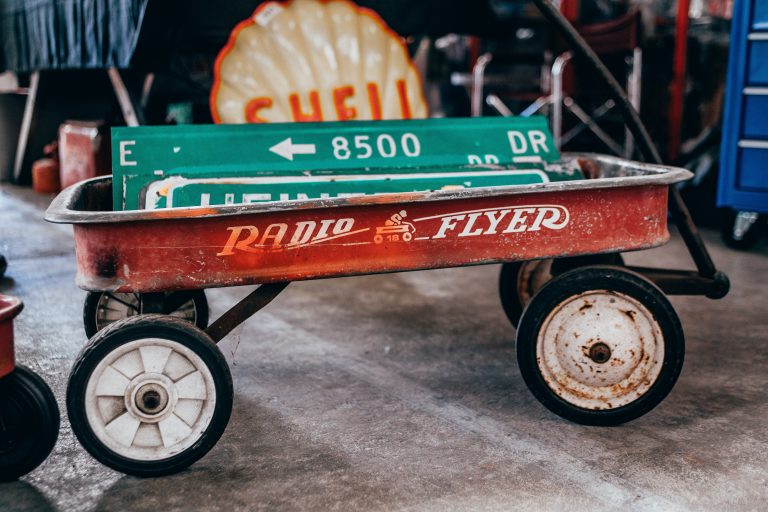










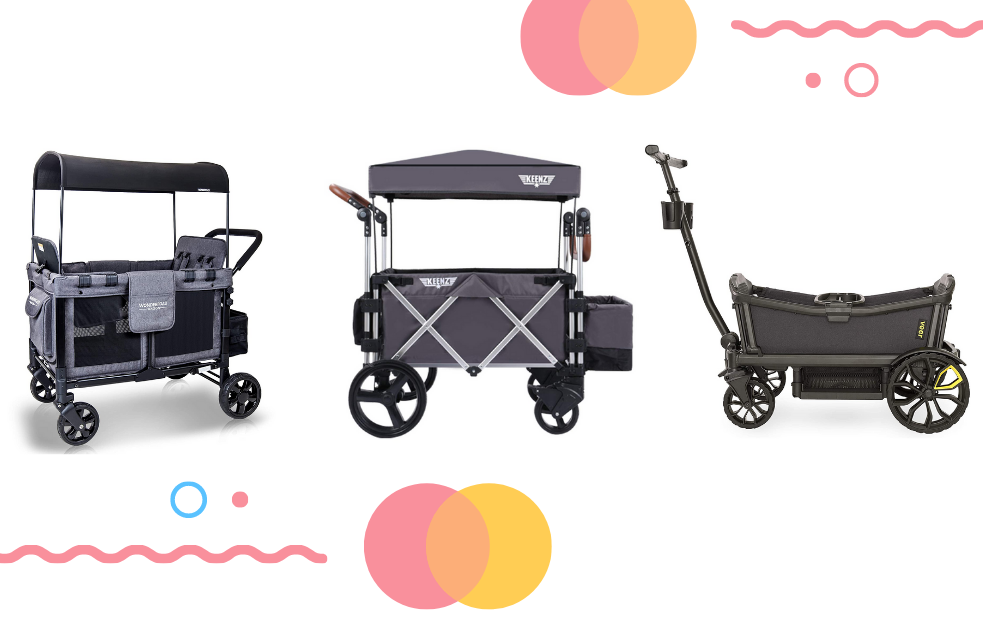
![Evenflo Pivot Xplore vs Keenz 7S vs Veer Cruiser Wagon: Best Wagon in [current_year] 20 Evenflo Pivot Xplore vs Keenz 7S vs Veer Cruiser](https://littlediscoverer.com/wp-content/uploads/2021/03/Evenflo-Pivot-Xplore-vs-Keenz-7S-vs-Veer-Cruiser.jpg)
